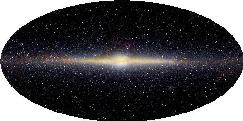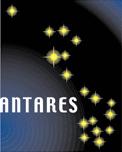Mass of the Milky Way disk
Our Milky Way galaxy
is a collection of some 100 billion stars; the Sun is just
one fairly typical member. While we can count up the number
of stars by doing surveys of the sky with large telescopes, one
can always wonder
are there still a lot of uncounted
stars out there that we have not yet seen; stars which would
be too dim to see even with our best telescopes?
This question has been addressed
in recent work by the DARKSTAR
research team at
Tuorla Observatory
. Most of the stars in the galaxy travel
in orbits in a flat system (called the disk) around a central,
spherical region (called the bulge). The Sun itself follows
a near-circular orbit located about halfway between the
center and the outer edge. A simple question to ask is how much
gravity do stars near the Sun experience; how much total gravitating
mass is there? To answer this,
Chris Flynn
of
Tuorla Observatory
and Johan Holmberg of Lund Observatory
have used data from the
European Space Agency's
Hipparcos
satellite on so-called
K giant stars. These stars
are cooler but much brighter than the Sun; indeed, the Sun
is expected to become a K giant itself some 5 billion years from
now.
The thickness of the Milky Way's disk is a balance between the total gravity of all the stars in it, and how fast they are individually moving. A given star, moving with a certain speed near the Sun, will rise upwards through the surrounding disk stars until the total gravity of all the stars below it pulls it back down again. All the stars are doing this at the same time, bobbing up and down in each other's gravitational field.
The team measured the speed at which the stars are moving
and at the same time the thickness of the layer of stars which
form the Milky Way's disk. Their new precise results confirmed their
analysis from almost 20 years ago: the thickness of the disk is
exactly what is expected if the visible stars control the motion
of each individual star. In other words, we understand how many stars
are out there and how they are all moving around. And that leads
us back to our initial question --- are a lot of the stars around the
Sun missing from our census? The answer is almost certainly not!
The research has been submitted to the journal Monthly Notices of the Royal Astronomical Society. |

The DIRBE view of our Milky Way Galaxy showing the disk (seen edge on) and the central bulge. The Sun is located some 30,000 light years from the central region, so that from our vantage point on the Earth we get this spectacular view of our own galaxy 'looking in'. DIstribution of red giants perpendicular to the Milky Way disk. The plot shows the number of K giant stars above the Sun seen in a survey cone taken with telescopes at Mount Stromlo Observatory. The distance of the stars above the Sun is expressed in parsecs (a little over 3 light years); the survey reaches stars more than 3000 light years away. The curve shows the expected number of stars based on a theoretical computation using the gravitational attraction of all the known stars around the Sun; it is a very good match to the data. 
The European Space Agency's Hipparcos satellite has measured distances and spatial motions of 125,000 nearby stars with a huge increase in precision compared to a previous 100 years of astronomical observations done with telescopes on the Earth. |
| Chris Flynn : Tuorla Observatory |
|
|
|

Research supported by the ANTARES program of the Academy of Finland |
